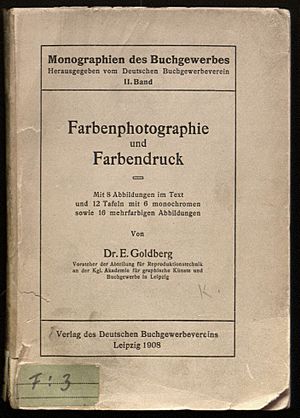Emanuel Goldberg facts for kids
Emanuel Goldberg (born August 31, 1881; died September 13, 1970) was a brilliant Israeli scientist and inventor. He was born in Moscow, Russia. Later, he moved to Germany and then to Israel. He once said he was "a chemist by learning, physicist by calling, and a mechanic by birth." This shows how many different skills he had!
Goldberg made many important discoveries and inventions related to light and how we record images. He was the first head of Zeiss Ikon, a very famous company that made cameras and other photo products in Dresden, Germany. Some of his amazing inventions include tiny microdots, the Kinamo movie camera, the Contax 35 mm camera, an early search engine, and tools for measuring how sensitive film is to light.
Contents
His Life Story
Emanuel Goldberg was born in Moscow on August 31, 1881. His father, Grigorii Ignat'evich Goldberg, was a respected Colonel in the Tsar's military medical group. Emanuel first wanted to be an engineer. Instead, he studied Chemistry at the University of Moscow and other universities in Germany. He stayed in Germany after 1904 because of unfair treatment towards Jewish people in Russia.
In 1906, he earned his Ph.D. from the University of Leipzig. He studied how light causes chemical reactions. After working as an assistant in Berlin, he became the head of the photography department at the Royal Academy of Graphic Arts in Leipzig from 1907 to 1917.
Leading Zeiss Ikon
In 1917, a company called Carl Zeiss hired Goldberg. He became a director at their photo products company, Ica, in Dresden. There, he introduced the Kinamo movie camera, which had a spring to power it. In 1926, four big photo companies joined together to form Zeiss Ikon. Goldberg led this new company.
Sadly, in 1933, he was taken by Nazis and had to escape to Paris. After working for Zeiss companies in France for four years, Goldberg moved to Palestine in 1937. There, he started his own lab, which later became Electro-Optical Industries ("El-Op"). He retired in 1960 but kept working on his research. He passed away in Tel Aviv on September 13, 1970.
Amazing Inventions
Goldberg was a true inventor. In 1902, he patented better ways to coat iron with zinc using electricity. He also wrote many papers on improving printing, like how to reduce wavy patterns in half-tone printing.
Tools for Photography
In 1910, he became well-known for a better way to make "Goldberg wedges." These were special tools used to measure how sensitive photographic film was to light. He also invented the Densograph. This machine made it much easier to measure how photographic films reacted to different amounts of light.
The Kinamo Movie Camera
Goldberg saw that more and more people wanted to make their own movies. So, he designed a very small 35 mm movie camera called the Kinamo. It came out in 1921. In 1923, they added a spring motor. This allowed people to hold the camera and film easily. Goldberg even made short films of his family to promote the camera. Famous filmmakers used the Kinamo in the late 1920s and early 1930s.
Tiny Microdots
In 1925, Goldberg showed how to make microdots. These were incredibly tiny images, so small that you could fit the text of 50 complete Bibles onto one square inch! This invention was often wrongly given to a made-up "Professor Zapp." This was probably a mix-up with Kurt Zapp, who taught German spies how to use microdot photography during World War II.
Goldberg also helped design the famous Contax 35 mm still camera. He studied how photographic images are formed, which he wrote about in his book Der Aufbau des photographischen Bildes (1922). He also developed the "Goldberg Condition," a rule for making high-quality photo prints.
Early Search Engine
In 1931, Goldberg introduced his "Statistical Machine." This was like a very early search engine! It used special light sensors and pattern recognition to search through information stored on rolls of microfilm. This technology was later used by other inventors and even inspired the idea of the imaginary Memex, a device for storing and linking information.
Helping Others Learn
In Germany, Goldberg was known for his educational displays at exhibitions. He also advised on aerial photography during the First World War. In Israel, he continued to help both civilian and military groups. He started a training program in Tel Aviv that taught advanced technical skills. Many of his students went on to help build Israel's high-tech industry.
Awards and Family
In 1968, Emanuel Goldberg received the Israel Prize, which is one of Israel's highest honors, for his work in exact science.
On June 28, 1907, Goldberg married Sophie Posniak. They had a son, Herbert, and a daughter, Renate Eva (who later changed her name to Chava). His great-granddaughter, Aspen Gollan, is a woodworker.
See also
- List of Israel Prize recipients


